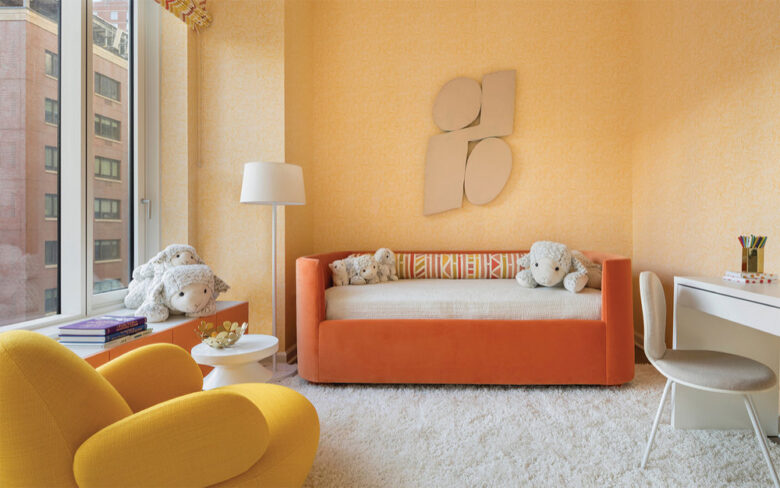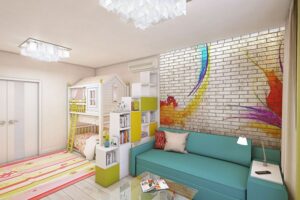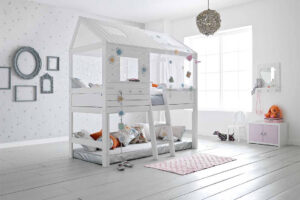Every parent wants to create a space for their child that’s not only beautiful but also supportive, calming, and safe. One of the most important elements in designing a child’s room is color. It doesn’t just decorate the walls — it influences emotions, development, energy levels, and even behavior.
Color can stimulate or soothe, spark imagination, or help with focus. While adults may not consciously notice the impact of their surroundings’ color palette, young children — especially those under 7 — react strongly to color signals. That’s why it’s essential to treat color as a tool for care and development.
In this article, we’ll explore how different shades affect children, which colors work best for certain areas, how to adjust your choices to suit a child’s age, and how to create a palette that supports your child’s emotional well-being and growth.
Why Color Matters in a Child’s Room
A child’s brain develops rapidly, especially in the first few years of life. Their nervous system is still forming, and their perception of the world is highly emotional and sensory-based. The colors surrounding them play a significant role in shaping moods and experiences.
The color environment can:
- Calm or stimulate the nervous system
- Influence attention span and focus
- Shape early preferences and a sense of harmony
- Encourage movement, play, or introspection
- Impact sleep quality, appetite, and emotional regulation
When chosen thoughtfully, the colors in a child’s room become more than just decoration — they become part of a nurturing developmental environment.
Basic Color Psychology in Interiors
Before diving into specific recommendations, it’s helpful to understand the general emotional associations of common colors:
| Color | Emotional Effect | Best for… |
|---|---|---|
| Blue | Calming, helps with concentration | Bedroom, relaxation areas |
| Green | Harmonizing, relieves anxiety, evokes nature | Study corner, play zone, sleeping area |
| Yellow | Stimulates mental activity, uplifting | Creative nook, play zone |
| Red | Exciting, can cause irritability in excess | Small accents only, not a background color |
| Orange | Warm, cheerful, promotes sociability | Play areas, activity zones |
| Pink | Comforting and tender, but overwhelming in large amounts | Infant rooms, soft accents |
| Purple | Inspires imagination, can feel heavy if too dark | Creative areas, accent walls |
| White | Clean and neutral, expands light | Background color, pairs well with others |
| Gray | Neutral and calm, but can feel cold | Works well with warmer tones |
| Black | Adds depth in small doses, too heavy as a dominant color | Frames, accents, furniture elements |
There are no inherently “good” or “bad” colors — just combinations and proportions that work better or worse in specific contexts.
Color Perception by Age
Color sensitivity in children depends not only on personality but also on their stage of development.
Newborns (0–6 months)
Best respond to high contrast visuals (black and white, bold shapes). They don’t fully perceive color yet — shadows and lighting are more important.
6 months – 2 years
Bright, saturated colors become more engaging. Children are drawn to simple, bold hues.
2–4 years
Color becomes part of play. Children learn to name and distinguish colors. Combining soft tones with brighter accents works best.
5–7 years
Color starts to carry emotional meaning. Children develop preferences and a basic sense of aesthetic. You can start introducing more complex combinations.
Best Colors for Different Areas of the Room
A child’s room is often multifunctional — it includes sleeping, playing, learning, and storage zones. Each area can be colored slightly differently, while maintaining harmony throughout the space.
Sleep zone
Colors: blue, light green, cream, soft pastels
Effect: soothes, prepares for rest, reduces overstimulation
Play zone
Colors: yellow, orange, green, soft blue
Effect: sparks curiosity and imagination, encourages activity
Study/creative area
Colors: soft yellow, mint, sandy tones
Effect: supports focus and mental clarity without strain
Storage and organization
Colors: neutrals like beige, gray, natural wood tones, with small color accents
Effect: helps visually structure the space, reduces clutter
Common Color Mistakes to Avoid
While color is powerful, it’s also easy to misuse. Too much brightness or contrast can overstimulate the nervous system and create visual fatigue.
Typical mistakes include:
- Using too many bright, loud colors
Overly saturated red or neon green walls may increase anxiety and overstimulation. - Decorating the entire room in one color
Even a favorite shade, like pink, can become tiring or overwhelming when overused. - Sharp contrasts without balance
Too many light-dark transitions without soft transitions cause discomfort. - Ignoring natural lighting
The same color will look very different in a north-facing versus south-facing room. - Choosing “adult” color schemes
Trendy all-gray or navy interiors may look stylish but feel cold or inappropriate for a child unless balanced with warm, playful accents.
How to Build a Balanced Color Palette for a Child’s Room
You don’t need to use every color in the rainbow. A simple rule of three works best: a base color, a supporting tone, and 1–2 accent colors.
Example palette structure:
Base color (60%) – light neutral like beige, pale gray, or mint
Supporting color (30%) – gentle pastels like soft yellow or blue
Accent color (10%) – a bold touch such as coral, teal, or forest green
Don’t forget to consider how the flooring, furniture, and lighting interact with these shades — everything should feel cohesive.
Color in a child’s room is more than aesthetics — it’s a meaningful part of their emotional world and early development. Carefully selected colors can help children feel calmer, sleep better, stay more focused, or feel energized when they need it.
When planning the palette, take into account your child’s age, the room’s function, natural lighting, and your child’s temperament. There’s no single perfect formula, but by understanding the basics of color psychology, you can create a space that nurtures your child’s growth and well-being.
And remember: children grow, and their preferences evolve. A flexible approach using textiles, wall art, and accessories will help you adjust the room without repainting every year.



